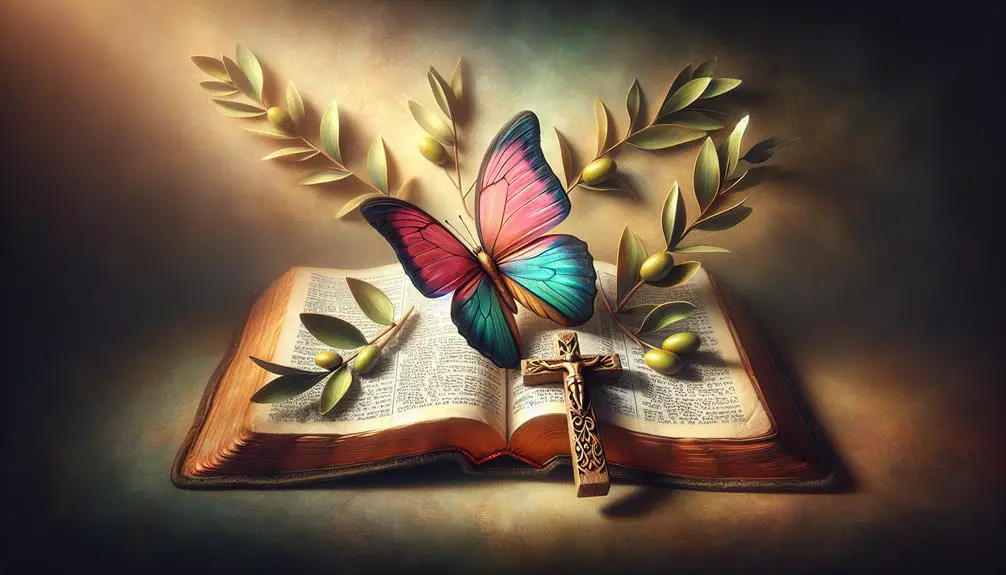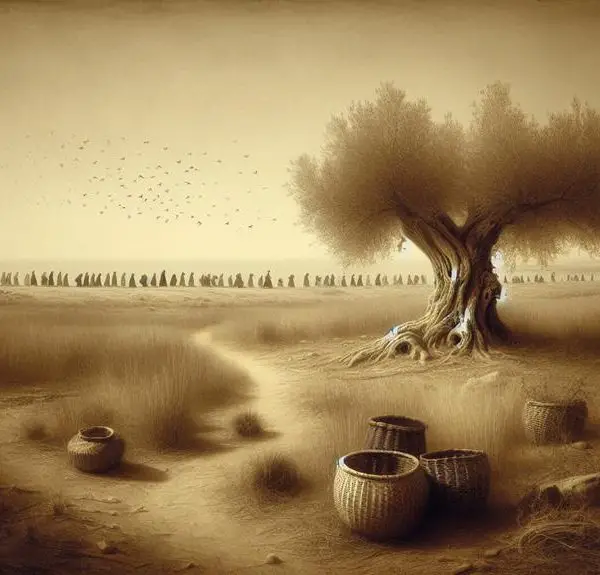A journey through biblical symbolism reveals the profound connection between butterflies and spiritual transformation, uncovering…

Butterfly Meaning in the Bible
In an era where emojis convey emotions, the symbolism of the butterfly in the Bible speaks volumes about transformation and renewal.
You might not find a direct reference to butterflies fluttering through the scriptures, but the themes they represent – resurrection, the soul's journey, and eternal life – are woven into the very fabric of biblical teachings.
As you explore the connection between this delicate creature and profound Christian beliefs, you'll uncover layers of meaning that resonate with the soul's quest for hope and rebirth.
Let's embark on this exploration together, and you'll see how ancient wisdom illuminates contemporary spiritual paths.
Key Takeaways
- Butterflies symbolize spiritual rebirth, transformation, and renewal in biblical contexts.
- Their metamorphosis from caterpillar to butterfly parallels spiritual growth and faith journey.
- The butterfly's lifecycle mirrors themes of resurrection and eternal life in Christian teachings.
- Nature's beauty, exemplified by the butterfly, reflects God's presence and encourages stewardship of creation.
Symbolism in Biblical Times

In Biblical times, symbolism served as a profound means to communicate divine truths and spiritual concepts, often transcending the limitations of literal interpretation. You'll find that the use of animals in parables and stories wasn't merely a choice of convenience or familiarity. Instead, it was a deliberate effort to embed layers of meaning, accessible through cultural interpretations and deep reflection.
Consider how animal parables, such as the serpent in the Garden of Eden or the dove returning to Noah's Ark, aren't just tales. They're imbued with intricate symbolism, each animal representing virtues, vices, or divine messages. The serpent, for instance, became synonymous with temptation and deceit, while the dove symbolized peace and the Holy Spirit's presence. These aren't arbitrary associations but are deeply rooted in the cultural and religious milieu of the time.
Cultural interpretations play a crucial role in deciphering these symbolic messages. What might seem like a straightforward animal reference can, upon deeper analysis, reveal insights into human behavior, moral dilemmas, or spiritual enlightenment. The context in which these symbols were used was essential for the contemporaneous audience to grasp the intended message fully.
Hence, understanding Biblical symbolism, including that of animals, requires you to delve into the cultural and historical context of the era. It's about seeing beyond the literal to the metaphorical, where even the simplest parable can hold profound spiritual significance. This approach not only enriches your comprehension of Biblical texts but also enhances your appreciation of the intricate ways in which symbolism was employed to convey divine truths.
The Transformation Process

You'll find the transformation process of a caterpillar into a butterfly in biblical texts is rich with layers of meaning, particularly emphasizing renewal and spiritual rebirth.
This metamorphosis symbolizes a profound journey from an earthly, limited form to one of liberation and beauty, mirroring spiritual awakening and resurrection themes.
In analyzing this journey, it's essential to grasp how it encapsulates the essence of spiritual transformation within the biblical narrative.
Metamorphosis as Renewal
Many regard the process of metamorphosis as a profound symbol of renewal and transformation, reflecting the spiritual journey of believers towards regeneration in biblical narratives. From a scientific perspective, this intricate process symbolizes not just a physical transformation but parallels personal growth and renewal. Here's how:
- Initiation: Just as a caterpillar must accept its nature to transform, you're called to embrace your potential for growth.
- Isolation: In its cocoon, the caterpillar isolates itself to rebuild; similarly, personal growth often requires solitude.
- Internal Change: Inside the cocoon, significant changes occur unseen, mirroring the internal spiritual transformation within believers.
- Emergence: The butterfly's emergence signifies rebirth; a metaphor for believers emerging renewed after a period of spiritual introspection and growth.
Spiritual Rebirth Symbolism
Exploring the symbolism of spiritual rebirth, the butterfly's transformation process offers a profound reflection on personal and spiritual renewal. This metamorphosis mirrors the path of personal growth and enlightenment, showcasing nature's lessons on evolving into our best selves. Through this lens, it's clear how the butterfly serves as a powerful emblem of spiritual rebirth.
Stage |
Symbolism |
Application to Personal Growth |
|---|---|---|
Egg |
Potential |
Recognizing inner potential |
Larva |
Foundation |
Building on core values |
Pupa |
Transition |
Embracing change |
Emergence |
Revelation |
Achieving self-realization |
Butterfly |
Rebirth |
Living with renewed purpose |
This table highlights the transformative stages of a butterfly, each paralleling important steps in the journey of personal and spiritual development, drawing from nature's lessons to inspire growth and rebirth.
Caterpillar to Butterfly Journey
Delving into the caterpillar to butterfly journey unveils a transformative process that mirrors profound spiritual and personal growth phases. This metamorphosis not only highlights the beauty of change but also emphasizes the ecological impact of each stage.
- Egg to Larva: The beginning, where potential is limitless.
- Molting Stages: As caterpillars grow, they shed their skin multiple times, symbolizing the necessary shedding of old ways to embrace growth.
- Pupa Formation: Entering a cocoon, a period of introspection and internal change, akin to spiritual rebirth.
- Emergence as a Butterfly: The culmination of transformation, representing freedom and the ecological balance restored through pollination.
Each phase of this journey is critical, reflecting life's cyclical nature and the importance of embracing change for personal and ecological well-being.
Resurrection and Renewal

You'll notice that the butterfly's journey from caterpillar to its final form mirrors the biblical themes of resurrection and renewal.
This metamorphosis symbolizes not just transformation, but a profound renewal of faith and the emergence of a new beginning inherent in resurrection.
Analyzing this connection provides a deeper understanding of how scripture employs natural symbolism to illustrate spiritual rebirth and renewal.
Symbolism of Transformation
In biblical symbolism, the butterfly represents a profound transformation, embodying the themes of resurrection and renewal central to Christian theology. This metamorphosis from caterpillar to butterfly mirrors the spiritual journey of believers, highlighting essential aspects of Christian faith:
- Change Symbolism: The butterfly's life cycle symbolizes the believer's transformation through faith, from worldly existence to spiritual awakening.
- Personal Growth: Just as the butterfly emerges stronger and more beautiful, individuals experience personal growth through trials and tribulations, refining their character and faith.
- Resurrection: The emerging butterfly serves as a powerful metaphor for resurrection, illustrating life after death and the promise of eternal life.
- Renewal: Each stage of the butterfly's life symbolizes renewal and hope, encouraging believers to embrace change as a pathway to spiritual enlightenment.
Renewal Through Faith
Exploring the concept of renewal through faith reveals a profound intersection of resurrection and renewal, deeply embedded within biblical narratives. This journey of faith isn't merely about adopting belief systems; it's an active engagement in spiritual growth, a process mirrored in the metamorphosis of a butterfly.
As you delve deeper, you'll find that faith's journey is marked by phases of introspection, struggle, and ultimately, transformation. This path isn't linear but cyclical, much like the seasons, symbolizing that spiritual growth requires continual renewal and rebirth.
Through this lens, the biblical stories that speak of resurrection aren't just historical accounts but are alive, offering insights into the dynamic nature of faith and its power to renew us from within.
Resurrection: A New Beginning
Understanding the concept of resurrection within the Bible unfolds a narrative of renewal, offering a fresh beginning that mirrors the transformative journey of faith. This theme resonates deeply with the symbol of the butterfly, embodying resurrection and renewal in a profound manner.
- Easter Connections: The resurrection of Jesus during Easter epitomizes the ultimate new beginning, paralleling the butterfly's emergence from its cocoon.
- Metamorphosis: Just as a butterfly transforms, believers experience spiritual renewal, signifying rebirth.
- Renewal Rituals: Various Christian traditions incorporate symbols of butterflies to celebrate resurrection, emphasizing continuous spiritual growth.
- Scriptural Symbolism: Biblical narratives often use nature to illustrate resurrection, with the butterfly serving as a powerful emblem of life after death, encouraging believers to embrace their own paths of renewal.
The Soul's Journey

Through the lens of biblical symbolism, the butterfly's metamorphosis vividly represents the soul's transformative journey from earthly existence to spiritual awakening. This transformation encapsulates the essence of mortal impermanence and ethereal symbolism, underlining the ephemeral nature of physical life and the eternal essence of the spiritual realm. It's an insightful reminder that the material world, much like the caterpillar's initial form, is but a temporary state before the soul's ascension to a higher plane of existence.
Your understanding of this symbolic metamorphosis encourages a deep contemplation of life's transient phases, urging you to recognize the impermanence of worldly concerns in comparison to the everlasting spirit. The butterfly, in its delicate beauty and seemingly weightless flight, serves as a metaphor for the soul's liberation from the confines of earthly limitations, embodying the transition from a state of spiritual dormancy to one of enlightened freedom.
This journey, depicted through the butterfly's stages of growth, mirrors the soul's quest for higher understanding and divine connection. It's a powerful portrayal of the soul's potential to transcend mortal constraints, shedding the cocoon of physical existence to embrace its true, ethereal nature.
In the biblical context, this symbolism aligns with teachings on the resurrection and the promise of eternal life, reinforcing the belief in a spiritual rebirth and the soul's ultimate return to its Creator. The butterfly thus emerges as a profound emblem of hope, transformation, and the soul's journey towards divine fulfillment, encapsulating the essence of spiritual awakening within the narrative of biblical teachings.
Life Cycle Parallels

Reflecting on the soul's transformative journey, it's enlightening to examine how the butterfly's life cycle offers profound parallels to spiritual rebirth and renewal. The butterfly metamorphosis, when juxtaposed with human spiritual awakening, unveils layers of meaning that are both intricate and divine. Through a blend of scientific analysis and theological interpretation, you'll find that this natural phenomenon resonates deeply with biblical teachings on transformation and regeneration.
Here are key parallels between the butterfly's life cycle and spiritual rebirth:
- Egg to Larva – Birth of Faith**: Just as a butterfly begins its life as an egg, spiritual awakening starts with the seed of faith. This initial phase is delicate and requires a nurturing environment to grow, mirroring the ecological impact of surroundings on an egg's development.
- Larva to Pupa – Period of Growth: The caterpillar's journey to becoming a pupa symbolizes the believer's period of growth and learning. This stage involves shedding old habits and beliefs, much like the caterpillar sheds its skin to make way for further development.
- Pupa – Time of Reflection: Inside the chrysalis, transformation occurs in seclusion and silence, paralleling the believer's introspective journey towards deeper spiritual understanding.
- Butterfly – Rebirth and Renewal**: Finally, the emergence of the butterfly symbolizes rebirth and renewal, reflecting the soul's liberation and transformation into a new being in Christ. This stage underscores the ecological impact of transformation, highlighting how spiritual renewal contributes to the flourishing of one's environment.
Through scientific analysis, the butterfly's life cycle not only underscores the ecological impact of transformation but also illustrates profound spiritual truths about rebirth and renewal.
Eternal Life and Hope

In the biblical narrative, butterflies serve as a compelling symbol of eternal life and hope, illuminating the promise of an everlasting existence beyond our earthly confines. This imagery, though not explicitly detailed in scripture, marries well with the thematic undertones of transformation and renewal prevalent throughout the biblical text. The metamorphosis from caterpillar to butterfly, a journey from a mundane existence to a spectacular rebirth, mirrors the Christian promise of resurrection and eternal life. This parallel draws a vivid line connecting the physical transformation of these creatures to the spiritual rebirth and renewal of faith in believers.
You'll find that the symbolism of butterflies extends to embodying hopeful beginnings. Just as a butterfly emerges from its cocoon, so too does the believer emerge from the trials of life, renewed and fortified. This aspect of the butterfly's life cycle reflects not only a physical rebirth but also a spiritual awakening, where renewed faith takes flight on the wings of newfound hope. The transformative journey of the butterfly, therefore, becomes a powerful metaphor for the believer's path toward salvation and eternal life.
Analyzing this symbolism further, it's clear that the butterfly motif in a biblical context encourages a reflection on life's transient nature and the promise of a glorious existence beyond. It whispers of hopeful beginnings, where despair and darkness give way to light and eternal joy, facilitated by a steadfast faith in the divine. Thus, the butterfly stands as a beacon of hope and a testament to the power of renewed faith, guiding believers toward the promise of an everlasting, joyful existence.
Relevance in Christian Teachings

Delving into Christian teachings, you'll discover that the symbolism of the butterfly isn't merely ornamental but deeply ingrained in the fabric of spiritual education and discourse. This imagery, while subtle, contributes significantly to understanding Christian ethics and moral teachings. Let's examine how the butterfly's transformation resonates within these teachings:
- Metamorphosis as a Symbol of Spiritual Rebirth: Just as a caterpillar transforms into a butterfly, Christians see this process as analogous to the spiritual rebirth of believers. This transformation reflects the profound change one undergoes upon accepting faith, emphasizing the core Christian ethic of renewal and rebirth.
- Resurrection and Eternal Life: The emergence of the butterfly from its cocoon echoes the Christian belief in resurrection and eternal life. This symbolizes hope and the promise of a new existence beyond death, reinforcing the moral teaching of life's sanctity and the eternal soul.
- Growth in Christian Virtues: The stages of a butterfly's life symbolize the stages of spiritual growth and the development of Christian virtues. Just as the butterfly must struggle to emerge from its cocoon, Christians are encouraged to persevere in their faith and grow in virtue, embodying the moral teachings of patience, faith, and transformation.
- Nature as a Reflection of Divine Creation: The beauty and intricacy of the butterfly serve as a reminder of God's presence in the natural world. This reinforces the Christian ethic of stewardship towards creation, highlighting the moral responsibility to care for and preserve the environment.
Through these aspects, the symbolism of the butterfly enriches Christian teachings, offering insightful perspectives on ethics, moral responsibilities, and spiritual growth.
Frequently Asked Questions
How Do Different Christian Denominations Interpret the Symbolism of Butterflies in the Context of Their Unique Doctrines and Practices?
You're exploring how Christian denominations uniquely interpret butterflies, focusing on their symbolic roles in Easter metamorphosis and Baptismal ceremonies.
This inquiry delves into the diverse doctrinal landscapes, revealing how these symbols weave into the fabric of spiritual practices.
It's a quest to understand the nuanced ways faith communities embody and articulate transformation and renewal.
Insightfully, you're unpacking the layers of meaning these traditions attach to butterflies, reflecting their deep-rooted beliefs and rituals.
Are There Specific Bible Passages That Mention Butterflies Directly, and How Do Scholars Interpret These References?
You won't find butterflies fluttering through the Bible's pages directly; their presence is symbolic, hinting at themes deeper than butterfly migrations or species diversity. Scholars delve into this absence, interpreting indirect references and parables that mirror the transformation and rebirth often symbolized by butterflies.
This analysis uncovers layers of meaning, inviting a scholarly exploration into how these ethereal creatures influence readings of biblical texts, without a straightforward mention, enriching our understanding of spiritual metamorphosis.
How Has the Symbolism of Butterflies in the Bible Influenced Christian Art and Architecture Throughout History?
Exploring how butterflies have inspired Christian art and architecture reveals deep layers of meaning. You'll find that color symbolism and metamorphosis metaphors pervade, reflecting themes of transformation and resurrection. These elements don't just decorate; they weave a narrative of faith and rebirth, echoing biblical teachings without direct reference.
From stained glass windows to church frescoes, butterflies symbolize the soul's journey, illustrating an enduring testament to faith's dynamic nature.
In What Ways Do Other Major World Religions View Butterflies, and How Do These Perspectives Compare to Christian Interpretations?
In exploring how major world religions view butterflies, you'll find Hinduism associates them with reincarnation, symbolizing the soul's journey and evolution.
Meanwhile, Buddhism sees butterflies as emblems of transformation, representing the change and impermanence inherent in life.
These perspectives offer a rich contrast to Christian interpretations, providing a broader understanding of the butterfly's symbolism across cultures.
Each tradition embeds unique spiritual insights into this common creature, reflecting diverse existential beliefs.
Can the Butterfly Symbolism in the Bible Be Connected to Modern Environmental Stewardship and Conservation Efforts Within Christian Communities?
Absolutely, you can draw a line between butterfly symbolism and environmental stewardship within Christian communities. Picture the delicate dance of a butterfly, instrumental in pollination roles, as a symbol for the delicate balance of our ecosystem. This imagery can inspire Christians to engage more deeply in conservation efforts, combating climate change.
Analyzing this connection offers a rich, insightful framework for understanding how faith can motivate actions to preserve God's creation.
Conclusion
Ironically, while the Bible doesn't specifically mention butterflies, their symbolic journey from caterpillar to winged beauty mirrors profound biblical themes.
You'd think a book so rich in metaphors would spotlight them, yet their absence speaks volumes. This omission cleverly underscores a universal truth: transformation and renewal often happen quietly, without fanfare.
Through this lens, the butterfly becomes a powerful emblem of faith's silent, transformative power, embodying resurrection, hope, and the soul's eternal journey in a way that words alone can't capture.



Sign up